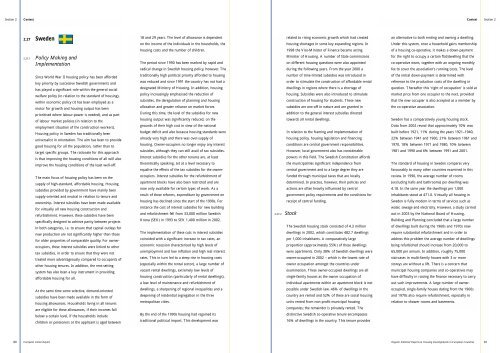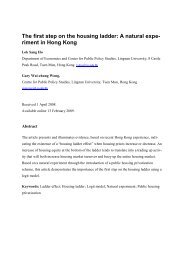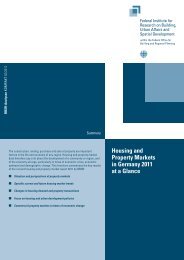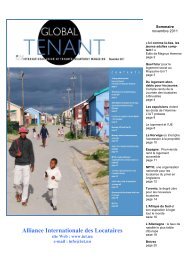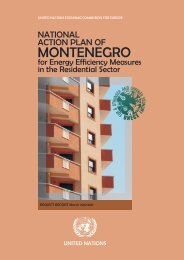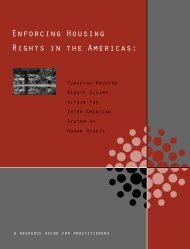housing developments in european countries - Department of ...
housing developments in european countries - Department of ...
housing developments in european countries - Department of ...
Create successful ePaper yourself
Turn your PDF publications into a flip-book with our unique Google optimized e-Paper software.
Section 2<br />
Context<br />
Context Section 2<br />
2.27 Sweden<br />
18 and 29 years. The level <strong>of</strong> allowance is dependent<br />
on the <strong>in</strong>come <strong>of</strong> the <strong>in</strong>dividuals <strong>in</strong> the households, the<br />
related to ris<strong>in</strong>g economic growth which had created<br />
<strong>hous<strong>in</strong>g</strong> shortages <strong>in</strong> some key expand<strong>in</strong>g regions. In<br />
an alternative to both rent<strong>in</strong>g and own<strong>in</strong>g a dwell<strong>in</strong>g.<br />
Under this system, once a household ga<strong>in</strong>s membership<br />
<strong>hous<strong>in</strong>g</strong> costs and the number <strong>of</strong> children.<br />
1998 the Vice-M<strong>in</strong>ister <strong>of</strong> F<strong>in</strong>ance became act<strong>in</strong>g<br />
<strong>of</strong> a <strong>hous<strong>in</strong>g</strong> co-operative, it makes a down-payment<br />
2.27.1 Policy Mak<strong>in</strong>g and<br />
Implementation<br />
The period s<strong>in</strong>ce 1990 has been marked by rapid and<br />
radical change <strong>in</strong> Swedish <strong>hous<strong>in</strong>g</strong> policy, however. The<br />
M<strong>in</strong>ister <strong>of</strong> Hous<strong>in</strong>g. A number <strong>of</strong> State commissions<br />
on different <strong>hous<strong>in</strong>g</strong> questions were also appo<strong>in</strong>ted<br />
dur<strong>in</strong>g the follow<strong>in</strong>g years. From the year 2000 a<br />
for the right to occupy a certa<strong>in</strong> flat/dwell<strong>in</strong>g that the<br />
co-operative owns, together with an ongo<strong>in</strong>g monthly<br />
fee to cover the association’s runn<strong>in</strong>g costs. The level<br />
S<strong>in</strong>ce World War II <strong>hous<strong>in</strong>g</strong> policy has been afforded<br />
key priority by successive Swedish governments and<br />
has played a significant role with<strong>in</strong> the general social<br />
welfare policy (<strong>in</strong> relation to the standard <strong>of</strong> <strong>hous<strong>in</strong>g</strong>),<br />
with<strong>in</strong> economic policy (it has been employed as a<br />
motor for growth and <strong>hous<strong>in</strong>g</strong> output has been<br />
prioritised where labour-power is needed), and as part<br />
<strong>of</strong> labour market policies (<strong>in</strong> relation to the<br />
employment situation <strong>of</strong> the construction workers).<br />
Hous<strong>in</strong>g policy <strong>in</strong> Sweden has traditionally been<br />
universalist <strong>in</strong> orientation. The aim has been to provide<br />
good <strong>hous<strong>in</strong>g</strong> for all the population, rather than to<br />
target specific groups. The rationale for this approach<br />
is that improv<strong>in</strong>g the <strong>hous<strong>in</strong>g</strong> conditions <strong>of</strong> all will also<br />
improve the <strong>hous<strong>in</strong>g</strong> conditions <strong>of</strong> the least well-<strong>of</strong>f.<br />
traditionally high political priority afforded to <strong>hous<strong>in</strong>g</strong><br />
was reduced and s<strong>in</strong>ce 1991 the country has not had a<br />
designated M<strong>in</strong>istry <strong>of</strong> Hous<strong>in</strong>g. In addition, <strong>hous<strong>in</strong>g</strong><br />
policy <strong>in</strong>creas<strong>in</strong>gly emphasised the reduction <strong>of</strong><br />
subsidies, the deregulation <strong>of</strong> plann<strong>in</strong>g and <strong>hous<strong>in</strong>g</strong><br />
allocation and greater reliance on market forces.<br />
Dur<strong>in</strong>g this time, the level <strong>of</strong> the subsidies for new<br />
<strong>hous<strong>in</strong>g</strong> output was significantly reduced, on the<br />
grounds <strong>of</strong> their high cost <strong>in</strong> view <strong>of</strong> the national<br />
budget deficit and also because <strong>hous<strong>in</strong>g</strong> standards were<br />
already very high and there was over-supply <strong>of</strong><br />
<strong>hous<strong>in</strong>g</strong>. Owner-occupiers no longer enjoy any <strong>in</strong>terest<br />
subsidies, although they can still avail <strong>of</strong> tax subsidies.<br />
Interest subsidies for the other tenures are, at least<br />
theoretically speak<strong>in</strong>g, set at a level necessary to<br />
equalise the effects <strong>of</strong> the tax subsidies for the owner-<br />
number <strong>of</strong> time-limited subsidies was <strong>in</strong>troduced <strong>in</strong><br />
order to stimulate the construction <strong>of</strong> affordable rental<br />
dwell<strong>in</strong>gs <strong>in</strong> regions where there is a shortage <strong>of</strong><br />
<strong>hous<strong>in</strong>g</strong>. Subsidies were also <strong>in</strong>troduced to stimulate<br />
construction <strong>of</strong> <strong>hous<strong>in</strong>g</strong> for students. These new<br />
subsidies are one-<strong>of</strong>f <strong>in</strong> nature and are granted <strong>in</strong><br />
addition to the general <strong>in</strong>terest subsidies directed<br />
towards all rental dwell<strong>in</strong>gs.<br />
In relation to the fram<strong>in</strong>g and implementation <strong>of</strong><br />
<strong>hous<strong>in</strong>g</strong> policy, <strong>hous<strong>in</strong>g</strong> legislation and f<strong>in</strong>anc<strong>in</strong>g<br />
conditions are central government responsibilities.<br />
However, local government also has considerable<br />
powers <strong>in</strong> this field. The Swedish Constitution affords<br />
the municipalities significant <strong>in</strong>dependence from<br />
central government and to a large degree they are<br />
<strong>of</strong> the <strong>in</strong>itial down-payment is determ<strong>in</strong>ed with<br />
reference to the production costs <strong>of</strong> the dwell<strong>in</strong>g <strong>in</strong><br />
question. Thereafter this ‘right <strong>of</strong> occupation’ is sold at<br />
market price from one occupier to the next, provided<br />
that the new occupier is also accepted as a member by<br />
the co-operative association.<br />
Sweden has a comparatively young <strong>hous<strong>in</strong>g</strong> stock.<br />
Data from 2002 reveal that approximately 10% was<br />
built before 1921, 11% dur<strong>in</strong>g the years 1921–1940,<br />
22% between 1941 and 1960, 21% between 1961 and<br />
1970, 18% between 1971 and 1980, 10% between<br />
1981 and 1990 and 6% between 1991 and 2001.<br />
The standard <strong>of</strong> <strong>hous<strong>in</strong>g</strong> <strong>in</strong> Sweden compares very<br />
favourably to many other <strong>countries</strong> exam<strong>in</strong>ed <strong>in</strong> this<br />
The ma<strong>in</strong> focus <strong>of</strong> <strong>hous<strong>in</strong>g</strong> policy has been on the<br />
supply <strong>of</strong> high-standard, affordable <strong>hous<strong>in</strong>g</strong>. Hous<strong>in</strong>g<br />
subsidies provided by government have ma<strong>in</strong>ly been<br />
supply-oriented and neutral <strong>in</strong> relation to tenure and<br />
ownership. Interest subsidies have been made available<br />
for virtually all new <strong>hous<strong>in</strong>g</strong> construction and<br />
refurbishment. However, these subsidies have been<br />
specifically designed to achieve parity between projects<br />
<strong>in</strong> both categories, i.e. to ensure that capital outlays for<br />
new production are not significantly higher than those<br />
for older properties <strong>of</strong> comparable quality. For owneroccupiers,<br />
these <strong>in</strong>terest subsidies were l<strong>in</strong>ked to other<br />
tax subsidies, <strong>in</strong> order to ensure that they were not<br />
treated more advantageously compared to occupants <strong>of</strong><br />
other <strong>hous<strong>in</strong>g</strong> tenures. In addition, the rent-sett<strong>in</strong>g<br />
system has also been a key <strong>in</strong>strument <strong>in</strong> provid<strong>in</strong>g<br />
affordable <strong>hous<strong>in</strong>g</strong> for all.<br />
occupiers. Interest subsidies for the refurbishment <strong>of</strong><br />
apartment blocks have also been restricted and are<br />
now only available for certa<strong>in</strong> types <strong>of</strong> work. As a<br />
result <strong>of</strong> these reforms, expenditure by government on<br />
<strong>hous<strong>in</strong>g</strong> has decl<strong>in</strong>ed s<strong>in</strong>ce the start <strong>of</strong> the 1990s. For<br />
<strong>in</strong>stance the cost <strong>of</strong> <strong>in</strong>terest subsidies for new build<strong>in</strong>g<br />
and refurbishment fell from 33,000 million Swedish<br />
Krona (SEK) <strong>in</strong> 1993 to SEK 1,400 million <strong>in</strong> 2002.<br />
The implementation <strong>of</strong> these cuts <strong>in</strong> <strong>in</strong>terest subsidies<br />
co<strong>in</strong>cided with a significant <strong>in</strong>crease <strong>in</strong> tax rates, an<br />
economic recession characterised by high levels <strong>of</strong><br />
unemployment and low <strong>in</strong>flation and high real <strong>in</strong>terest<br />
rates. This <strong>in</strong> turn led to a steep rise <strong>in</strong> <strong>hous<strong>in</strong>g</strong> costs<br />
(especially with<strong>in</strong> the rental sector), a large number <strong>of</strong><br />
vacant rental dwell<strong>in</strong>gs, extremely low levels <strong>of</strong><br />
<strong>hous<strong>in</strong>g</strong> construction (particularly <strong>of</strong> rental dwell<strong>in</strong>gs),<br />
a low level <strong>of</strong> ma<strong>in</strong>tenance and refurbishment <strong>of</strong><br />
funded through municipal taxes that are locally<br />
determ<strong>in</strong>ed. In practice, however, their policies and<br />
actions are <strong>of</strong>ten heavily <strong>in</strong>fluenced by central<br />
government policy requirements and the conditions for<br />
receipt <strong>of</strong> central fund<strong>in</strong>g.<br />
2.27.2 Stock<br />
The Swedish <strong>hous<strong>in</strong>g</strong> stock consisted <strong>of</strong> 4.3 million<br />
dwell<strong>in</strong>gs <strong>in</strong> 2002, which constitutes 482.7 dwell<strong>in</strong>gs<br />
per 1,000 <strong>in</strong>habitants. A comparatively large<br />
proportion (approximately 55%) <strong>of</strong> these dwell<strong>in</strong>gs<br />
were apartments. Only 38% <strong>of</strong> Swedish dwell<strong>in</strong>gs were<br />
owner-occupied <strong>in</strong> 2002 – which is the lowest rate <strong>of</strong><br />
owner occupation amongst the <strong>countries</strong> under<br />
exam<strong>in</strong>ation. These owner-occupied dwell<strong>in</strong>gs are all<br />
s<strong>in</strong>gle-family houses as the owner occupation <strong>of</strong><br />
<strong>in</strong>dividual apartments with<strong>in</strong> an apartment block is not<br />
review. In 1990, the average number <strong>of</strong> rooms<br />
(exclud<strong>in</strong>g halls and bathrooms) per dwell<strong>in</strong>g was<br />
4.18. In the same year the dwell<strong>in</strong>gs per 1,000<br />
<strong>in</strong>habitants stood at 471.0. Virtually all <strong>hous<strong>in</strong>g</strong> <strong>in</strong><br />
Sweden is fully modern <strong>in</strong> terms <strong>of</strong> services such as<br />
water, sewage and electricity. However, a study carried<br />
out <strong>in</strong> 2003 by the National Board <strong>of</strong> Hous<strong>in</strong>g,<br />
Build<strong>in</strong>g and Plann<strong>in</strong>g concluded that a large number<br />
<strong>of</strong> dwell<strong>in</strong>gs built dur<strong>in</strong>g the 1960s and 1970s now<br />
require substantial refurbishment and <strong>in</strong> order to<br />
address this problem the average number <strong>of</strong> dwell<strong>in</strong>gs<br />
be<strong>in</strong>g refurbished should <strong>in</strong>crease from 20,000 to<br />
65,000 per annum. In addition, roughly 75,000<br />
staircases <strong>in</strong> multi-family houses with 3 or more<br />
storeys are without a lift. There is a concern that<br />
municipal <strong>hous<strong>in</strong>g</strong> companies and co-operatives may<br />
have difficulty <strong>in</strong> rais<strong>in</strong>g the f<strong>in</strong>ance necessary to carry<br />
out such improvements. A large number <strong>of</strong> owner-<br />
At the same time some selective, demand-oriented<br />
subsidies have been made available <strong>in</strong> the form <strong>of</strong><br />
<strong>hous<strong>in</strong>g</strong> allowances. Households liv<strong>in</strong>g <strong>in</strong> all tenures<br />
are eligible for these allowances, if their <strong>in</strong>comes fall<br />
below a certa<strong>in</strong> level, if the households <strong>in</strong>clude<br />
children or pensioners or the applicant is aged between<br />
dwell<strong>in</strong>gs, a sharpen<strong>in</strong>g <strong>of</strong> regional <strong>in</strong>equalities and a<br />
deepen<strong>in</strong>g <strong>of</strong> residential segregation <strong>in</strong> the three<br />
metropolitan cities.<br />
By the end <strong>of</strong> the 1990s <strong>hous<strong>in</strong>g</strong> had rega<strong>in</strong>ed its<br />
traditional political import. This development was<br />
possible under Swedish law. 46% <strong>of</strong> dwell<strong>in</strong>gs <strong>in</strong> the<br />
country are rented and 52% <strong>of</strong> these are social <strong>hous<strong>in</strong>g</strong><br />
units rented from non-pr<strong>of</strong>it municipal <strong>hous<strong>in</strong>g</strong><br />
companies; the rema<strong>in</strong>der is privately rented. The<br />
dist<strong>in</strong>ctive Swedish co-operative tenure encompasses<br />
16% <strong>of</strong> dwell<strong>in</strong>gs <strong>in</strong> the country. This tenure provides<br />
occupied, s<strong>in</strong>gle-family houses dat<strong>in</strong>g from the 1960s<br />
and 1970s also require refurbishment, especially <strong>in</strong><br />
relation to shower rooms and basements.<br />
80 European Union Report<br />
Regular National Report on Hous<strong>in</strong>g Developments <strong>in</strong> European Countries<br />
81


